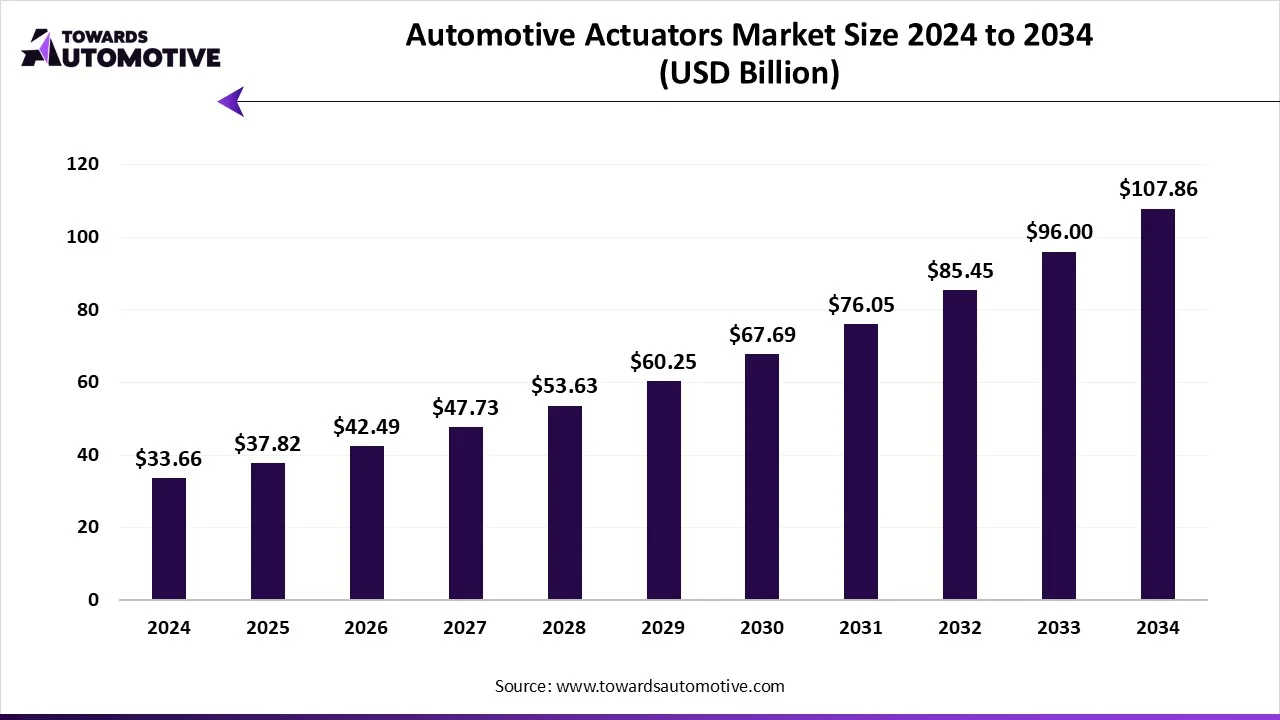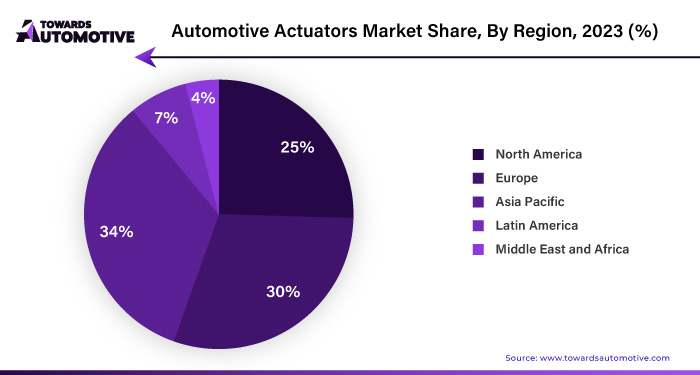April 2025
The automotive actuators market is expected to grow from USD 37.82 billion in 2025 to USD 107.86 billion by 2034, with a CAGR of 12.35% throughout the forecast period from 2025 to 2034.
Unlock Infinite Advantages: Subscribe to Annual Membership
Rapid advancements in the automotive industry, particularly in developing autonomous vehicles and advanced driver assistance systems (ADAS) like adaptive cruise control (ACC), automatic braking assist, and lane-keeping assist, have significantly increased the demand for actuators. Modern vehicles are equipped with sophisticated ADAS features and adaptive headlight systems (AFS), driving the adoption of actuators to enhance vehicle control and safety. Actuators play a crucial role in these systems by converting energy into motion, utilizing control signals and power sources such as electric current, hydraulic pressure, or pneumatic pressure.
Key drivers of the global automotive actuators market include the emphasis on automobile engine miniaturization, government regulations on vehicle emissions, and the growing demand for energy-efficient vehicles. Factors like increasing traffic accidents, ongoing technological advancements, and innovations in the automotive sector also contribute to market growth.
However, challenges such as premature wear of actuators present obstacles to market expansion. Nonetheless, opportunities abound, especially in developing countries where the use of actuators is on the rise, coupled with government initiatives promoting electric vehicles.
Moreover, the market is witnessing a decline in the cost of brushless DC (BLDC) actuators due to reduced power loss, making them more attractive for various automotive applications. Furthermore, the rising consumer demand for energy-efficient vehicles is compelling significant companies to invest in research and development (R&D) activities. For instance, Kierkert AG recently introduced a new financing scheme for plugin hybrid vehicles.
The automotive industry continues to witness growth in sales of both passenger and commercial vehicles, prompting Original Equipment Manufacturers (OEMs) to prioritize interior design enhancements aimed at enhancing passenger safety and comfort. As part of this initiative, actuators have been integrated with additional features to make seating more attractive and intelligent.
Actuators play a crucial role in adjusting various aspects of vehicle seats, including lumbar support, seat angle, and seat slide. A wide range of vehicle adjustment actuators are available in the market, including geared motors for tilt adjustment, double output shafts for track drives, and linear actuators for height and tilt adjustment.
The automotive actuator industry is primarily driven by factors such as the overall growth of the automotive sector and the increasing demand for smaller vehicles to enhance fuel efficiency. Rising safety concerns and incidents such as drunk driving, reckless driving, and loss of control have led to the installation of car actuators in a more significant number of vehicles, with easier installation processes.
Moreover, increasing environmental consciousness has prompted some governments to incentivize using electric and hydraulic actuators in the automotive industry. The automotive actuator market is expanding as there is a growing need for fuel-efficient actuators to help prevent engine combustion and reduce greenhouse gas emissions. Additionally, these actuators are equipped with Internet of Things (IoT) technology, allowing them to recognize vehicle movement, speed, and distance.
Furthermore, factors such as the rising sales of non-electric vehicles and increased utilization of HVAC and cooling systems are expected to drive the automotive market in the forecast period. The demand for seat adjustment actuators is anticipated to grow significantly due to the increasing sales of large SUVs and premium cars worldwide. OEMs are increasingly leveraging electronics to control nearly every aspect of the vehicle, aiming to enhance the overall passenger experience.
The Asia-Pacific market is poised for rapid growth, with countries like India, Japan, and China gradually emerging as major automobile manufacturers and suppliers to markets such as the USA and Germany. This growth is primarily driven by increasing sales of passenger cars and commercial vehicles.

Robert Bosch Ltd., Nidec Corporation, Denso Corporation, Johnson Electric, and Aptiv Corp. are among the key players in the market, each holding a significant share. Robert Bosch GmbH, in particular, supplies actuators to numerous major automobile manufacturers worldwide, including Volkswagen, General Motors, BMW, Daimler, Ford, and Peugeot. These companies operate across Asia Pacific, Europe, and North America.
An actuator is a component of a machine responsible for moving and controlling its operation or a specific part of it, such as opening or closing a valve. In automotive applications, actuators play crucial roles in various systems including throttle control, braking, headlight adjustment, HVAC (heating, ventilation, and air conditioning), electric clutch actuation, and engine shutdown. These actuators are integral to performing essential functions within the vehicle.
By Application Type
By Vehicle Type
By Geography
April 2025
April 2025
April 2025
April 2025
Dr. Arjun Patel is a distinguished expert in the automotive industry, holding advanced degrees in Automotive Engineering and Mechanical Engineering. His expertise spans automotive market dynamics, technological advancements, and sustainable practices. Dr. Patel excels in conducting in depth research and analysis on market trends, consumer preferences, and the economic implications within the automotive sector. He is renowned for his insightful publications on topics such as electric vehicles, autonomous driving technologies, and the evolution of sustainable transportation solutions. Dr. Patels research contributions have significantly advanced understanding in the field, earning him recognition as a leading authority in automotive research and analysis.
We offer automotive expertise for market projections and customizable research, adaptable to diverse strategic approaches.
Contact Us